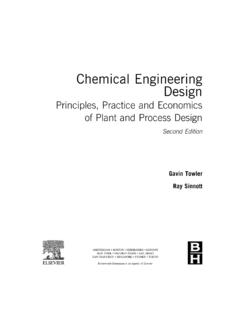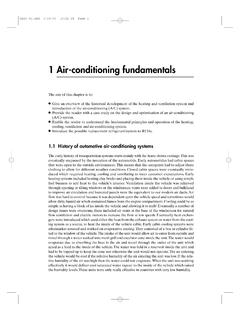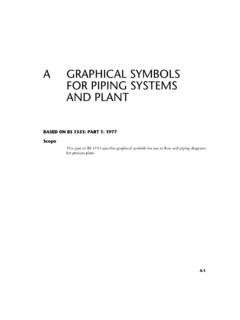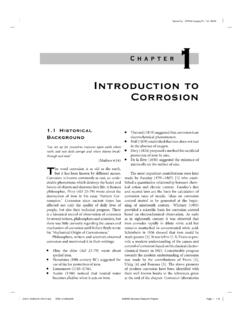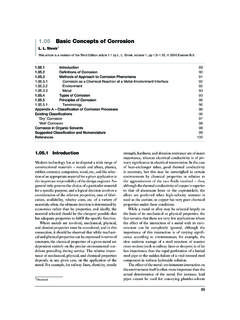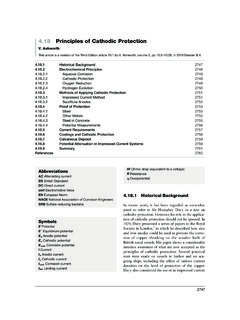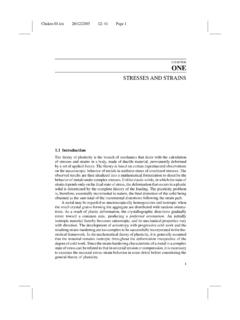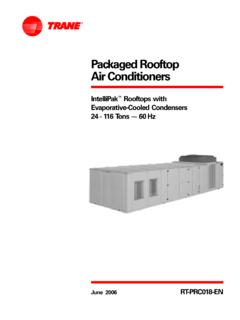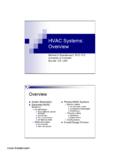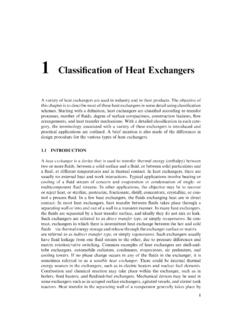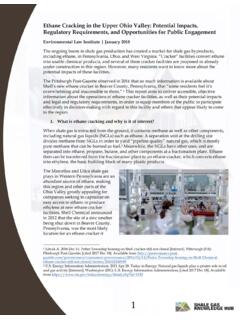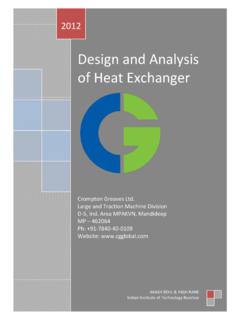Transcription of CHAPTER Utilities and Energy Efficient Design 3
1 CHAPTER3 Utilities and Energy Efficient DesignKEY LEARNING OBJECTIVES How processes are heated and cooled The systems used for delivering steam, cooling water, and other site Utilities Methods used for recovering process waste heat How to use the pinch Design method to optimize process heat recovery How to Design a heat -exchanger network How Energy is managed in batch few chemical processes are carried out entirely at ambient temperature. Most require processstreams to be heated or cooled to reach the desired operation temperature, to add or remove heatsof reaction, mixing, adsorption, etc., to sterilize feed streams, or to cause vaporization or condensa-tion.
2 Gas and liquid streams are usually heated or cooled by indirect heat exchange with anotherfluid: either another process stream or a utility stream such as steam, hot oil, cooling water, orrefrigerant. The Design of heat exchange equipment for fluids is addressed in CHAPTER 19. Solids areusually heated and cooled by direct heat transfer, as described in CHAPTER 18. This CHAPTER beginswith a discussion of the different Utilities that are used for heating, cooling, and supplying otherneeds such as power, water, and air to a consumption of Energy is a significant cost in many processes. Energy costs can be reducedby recovering waste heat from hot process streams and by making use of the fuel value of wastestreams.
3 Section discusses how to evaluate waste stream combustion as a source of processheat. Section introduces other heat recovery it is economically attractive, heating and cooling are accomplished by heat recoverybetween process streams. The Design of a network of heat exchangers for heat recovery can be acomplex task if there are many hot and cold streams in a process. Pinch analysis, introduced inSection , is a systematic method for simplifying this Efficient use of Energy in batch and cyclic processes is made more complicated by thesequential nature of process operations. Some approaches to Energy Efficient Design of batch andcyclic processes are discussed in Section Engineering Design , Second Edition 2013 Elsevier Ltd.
4 All rights word Utilities is used for the ancillary services needed in the operation of any productionprocess. These services are normally supplied from a central site facility, and for fired for process oil or specialized heat transfer for process for general supplies (usually nitrogen)Most plants are located on sites where the Utilities are provided by the site infrastructure. The pricecharged for a utility is mainly determined by the operating cost of generating and transmitting theutility stream. Some companies also include a capital recovery charge in the utility cost, but if this isdone then the offsite (OSBL)
5 Capital cost of projects must be reduced to avoid double counting andbiasing the project capital- Energy trade-off, leading to poor use of smaller plants purchase Utilities over the fence from a supplier such as a larger site or autility company, in which case the utility prices are set by contract and are typically pegged to theprice of natural gas, fuel oil, or utility consumption of a process cannot be estimated accurately without completing thematerial and Energy balances and carrying out a pinch analysis, as described in Section Thepinch analysis gives targets for process heat recovery and hence for the minimum requirements of hotand cold Utilities .
6 More detailed optimization then translates these targets into expected demands forfired heat , steam, electricity, cooling water, and refrigeration. In addition to the Utilities required forheating and cooling, the process may also need process water and air for applications such as wash-ing, stripping, and instrument air supply. Good overviews of methods for Design and optimization ofutility systems are given by Smith (2005) and Kemp (2007). electricity demand of the process is mainlydetermined by the work required for pumping,compression, air coolers, and solids-handling operations, but also includes the power needed forinstruments, lights, and other small users.
7 Thepower required may be generated on site, but willmore usually be purchased from the local supply company. Some plants generate their own electri-city using a gas-turbine cogeneration plant with a heat recovery steam generator (waste- heat boiler)to raise steam (Figure ). The overall thermal efficiency of such systems can be in the range 70%to 80%; compared with the 30% to 40% obtained from a conventional power station, where the104 CHAPTER 3 Utilities and Energy Efficient Designheat in the exhaust steam is wasted in the condenser. The cogeneration plant can be sized to meetor exceed the plant electricity requirement, depending on whether the export of electricity is anattractive use of capital.
8 This make or buy scenario gives chemical producers strong leveragewhen negotiating electric powercontracts and they are usually able to purchase electricity at orclose to wholesale prices. Wholesale electricity prices vary regionally (see for details),but are typically about $ in North America at the time of voltage at which the supplyis taken or generated will depend on the demand. In the UnitedStates, power is usually transmitted over long distances at 135, 220, 550, or 750 kV. Local substationsstep the power down to 35 to 69 kV for medium voltage transmission and then to 4 to 15 kV local dis-tribution lines. Transformers at the plant are used to step down the power to the supply voltages usedon site.
9 Most motors and other process equipment run on 208 V three-phase power, while 120/240 Vsingle-phase power is used for offices, labs, and control any site it is always worth considering driving large compressors and pumps with steamturbines instead of electric motors and using the exhaust steam for local process power is rarely used for heating in large-scale chemical plants, although it is often usedin smaller batch processes that handle nonflammable materials, such as biological processes. Themain disadvantages of electrical heating for large-scale processes are: heat from electricity is typically two to three times more expensive than heat from fuels, becauseof the thermodynamic inefficiency of power generation.
10 Electric heating requires very high power draws that would substantially increase the electricalinfrastructure costs of the site. Electric heating apparatus is expensive, requires high maintenance, and must comply withstringent safety requirements when used in areas where flammable materials may be present. Electric heaters are intrinsically less safe than steam systems. The maximum temperature that asteam heater can reach is the temperature of the steam. The maximum temperature of an electricAirFuelCombustorCompressorSupple mentaryfuelSecondarycombustorWaste heatboilerBoilerfeedwaterTurbineDynamoSt eamFluegas tostackFIGURE cogeneration is determined by the temperature controller (which could fail) or by burn-out of theheating element.
